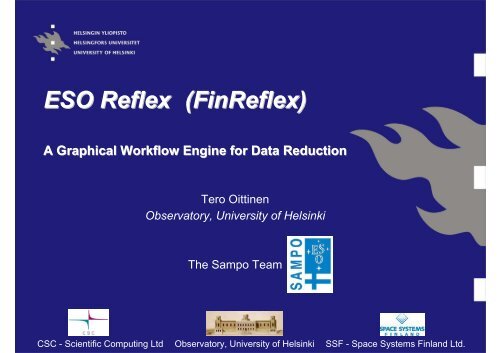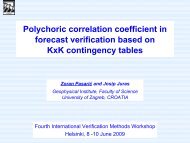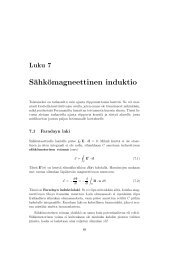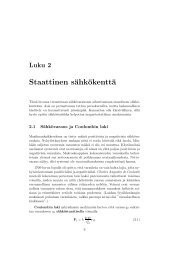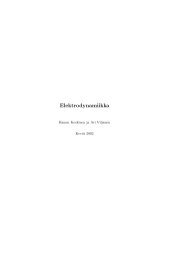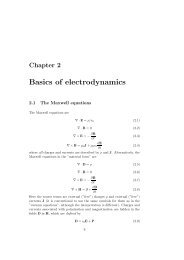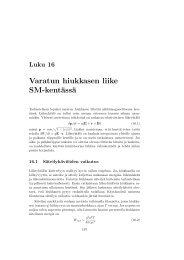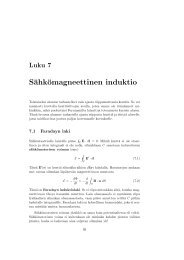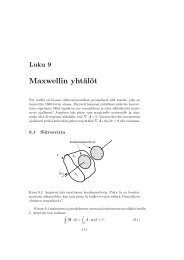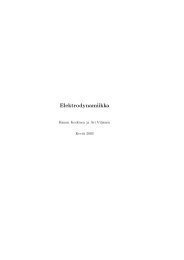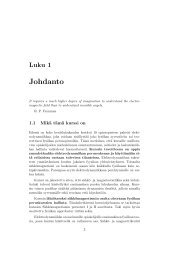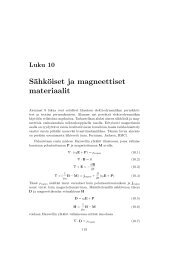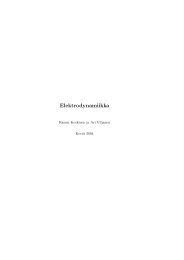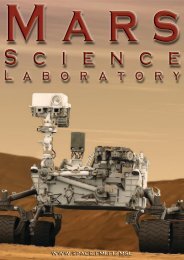ESO Reflex (FinReflex) - Wiki
ESO Reflex (FinReflex) - Wiki
ESO Reflex (FinReflex) - Wiki
- No tags were found...
You also want an ePaper? Increase the reach of your titles
YUMPU automatically turns print PDFs into web optimized ePapers that Google loves.
<strong>ESO</strong> <strong>Reflex</strong> (Fin<strong>Reflex</strong>)A Graphical Workflow Engine for Data ReductionTero OittinenObservatory, University of HelsinkiThe Sampo TeamCSC - Scientific Computing Ltd Observatory, University of Helsinki SSF - Space Systems Finland Ltd.
Motivation• <strong>ESO</strong> provides pipeline “recipes” for all VLT instruments• They remove the instrumental signature and are used forquality control at <strong>ESO</strong> and distributed to the community• All newer recipes are compiled C code using the CPL libraryand tools to run them offline are available (Gasgano andEsoRex)• Many older general purpose reduction and analysis systemsremain in wide use (MIDAS/IRAF etc)• Sampo• Finland joined <strong>ESO</strong> in July 2004. As part of its joining feeresources were made available to perform a three year study offuture needs for the <strong>ESO</strong> community in the area of data reductionand analysis environments.• The project started in January 2005 and was managed by <strong>ESO</strong>with the staff based in Finland.SummerSchool_<strong>Reflex</strong>_080527_00.pptTero Oittinen - 2008
The Sampo Approach• A data reduction system for the end user requires:• Modular recipes to provide access to intermediate products• Interactive tools, defined or customized by the user, to analyzeintermediate and final data products• Effective access to legacy software• A user-friendly, intuitive and flexible interface• Simple access to external VO (etc) services within the sameworkflows?• Sampo, and specifically the <strong>ESO</strong> <strong>Reflex</strong> tool, tries to addressthe interface issue, with a focus on the use case of <strong>ESO</strong> data:• Common front-end interface to cope with the potentially largenumber of <strong>ESO</strong> instruments in a uniform and maintainable way• General invoker for CPL-based recipes• General invoker for Python scripts (hence PyRAF & PyMidas)• Easy incorporation of other tools (including WebServices)SummerSchool_<strong>Reflex</strong>_080527_00.pptTero Oittinen - 2008
<strong>ESO</strong> <strong>Reflex</strong>• <strong>ESO</strong> <strong>Reflex</strong> is a graphical workflow engine for executing CPLRecipes and other tools• Not instrument specific• Easy inclusion of external tools and scripts• Allows user interaction during execution• Based on Taverna• The Taverna workbench• a free software tool for designing and executing workflows• an open source Java workflow system created by the myGridproject,• allows users to integrate many different software tools, includingweb services• provides a desktop authoring environment and enactment enginefor scientific workflows expressed in Scufl (Simple ConceptualUnified Flow language).• allows a user with limited computing background and limitedtechnical resources and support to construct highly complexanalyses over public and private data and computationalresources, all from a standard PC, UNIX box or Apple computer.SummerSchool_<strong>Reflex</strong>_080527_00.pptTero Oittinen - 2008
• <strong>Reflex</strong> allows the user to define andexecute a sequence of recipesusing an easy and flexible GUI.• A sequence of recipes can be runas a workflow where the output of arecipe is used as an input to anotherrecipe.• The workflow defines the pipelinefrom raw data to reduced data.• The user can either use theapplication to execute standardworkflows provided by <strong>ESO</strong> ordefine workflows of his/her own.• The standard workflows can also beeasily modified to suit any particularneeds the user might have.SummerSchool_<strong>Reflex</strong>_080527_00.pptTero Oittinen - 2008
• Error detection and recovery• Errors on during recipe execution are detected by <strong>Reflex</strong>• Appropriate actions can be taken by the userSummerSchool_<strong>Reflex</strong>_080527_00.pptTero Oittinen - 2008
• Step-by-step execution• In interactive mode the user can make changes to input data andparameters during executionSummerSchool_<strong>Reflex</strong>_080527_00.pptTero Oittinen - 2008
• Parallel Execution• The recipes on a parallelworkflow execute in parallel• Full advantage on multiprocessoror multi-coremachinesSummerSchool_<strong>Reflex</strong>_080527_00.pptTero Oittinen - 2008
• Customisability• The user can easily modifythe workflows• Python and IDL scripts canbe included in the workflows• Any system command canalso be invoked from theworkflows• Easy access to VO andother web servicesSummerSchool_<strong>Reflex</strong>_080527_00.pptTero Oittinen - 2008
• FITS-file handling• Based on Gasgano• The instrument-specific tags ofthe FITS-files are automaticallyextracted from the FITSheaders• Tag-checking: only compatibleFITS-files are allowed in inputsSummerSchool_<strong>Reflex</strong>_080527_00.pptTero Oittinen - 2008
Example of an <strong>ESO</strong> <strong>Reflex</strong> workflowbased on calibration recipes for theVLT FORS2 instrument in MXUmode.The input data are represented bythe light-colouredboxes at the top.The data flow through theprocessors in the middle section toproduce the outputs shown at thebottom.The orange circular symbolindicates that one recipe willexecute in interactive modeSummerSchool_<strong>Reflex</strong>_080527_00.pptTero Oittinen - 2008
• FORS Spectroscopic CalibrationSummerSchool_<strong>Reflex</strong>_080527_00.pptTero Oittinen - 2008
How to get an <strong>ESO</strong> <strong>Reflex</strong>?• Required hardware for <strong>Reflex</strong>• A modern Linux or Mac OSX computer with at least 1 GB memory andsufficient disk space for data• Supported Operating systems:SummerSchool_<strong>Reflex</strong>_080527_00.ppt- Fedora Core 3/4/5/6- Red Hat Enterprise Linux 4- Ubuntu Linux- Mac OSX Intel **/*- Mac OSX Power PC *• Required software for <strong>Reflex</strong>• Java 1.5 SDK including Java Runtime Environment (or later)• <strong>ESO</strong> Scisoft VI (or later)• Download <strong>Reflex</strong> kit• The <strong>Reflex</strong> kit contains all necessary pipeline products and third-partysoftware.• The disk space required for installation is approximately 95 MB.• If you would like to test the current <strong>ESO</strong> <strong>Reflex</strong> beta release pleasecontact reflex@eso.org in order to get a link to the kit.Tero Oittinen - 2008
Fin<strong>Reflex</strong>• Fin<strong>Reflex</strong> is a new version for Finnish enviroments• Project 1.2.2008 – 31.1.2009• Based on <strong>ESO</strong> <strong>Reflex</strong> (Taverna).• Will be customized for Finnish astronomers & other customers• Migration to Taverna 1.7/2.0• <strong>ESO</strong> <strong>Reflex</strong> is based on Taverna 1.6- Changes to building process (Maven builder) & Core API & UI• General Interfaces• WebServices, Data Mining, Remote subworkflows• Better integration to specific tools• Data Manager• Currently depend on code from <strong>ESO</strong> Gasgano.• Two main tasks: Data Organizer & Data ViewerSummerSchool_<strong>Reflex</strong>_080527_00.pptTero Oittinen - 2008
More info•Observatory, University of HelsinkiTero Oittinentero.oittinen@helsinki.fi•<strong>ESO</strong>www.eso.org/samporeflex@eso.orgSummerSchool_<strong>Reflex</strong>_080527_00.pptTero Oittinen - 2008


